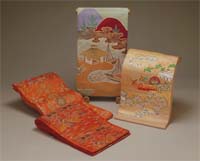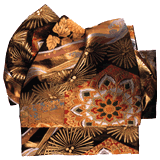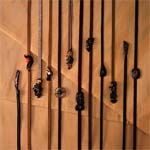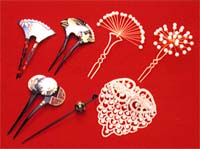|
 Kimonos
are worn with sashes called obi, which hold the kimono in place
and keep the front closed. Obi not only serve this practical
function, but are beautiful as well. Obi are about 4 meters (13
feet) long and 30 centimeters (12 inches) wide. There are two types
of obi: fukuro-obi, which have a design only on one side;
and nagoya-obi, which are narrower in the middle to make them
easier to tie around the body. Obi known as nishiki-obi,
made in Kyoto, are prized for the lavish colors such as gold and silver
that are woven into them. Obi known as hakata-kenjo, made
in Fukuoka Prefecture, are also well known. Kimonos
are worn with sashes called obi, which hold the kimono in place
and keep the front closed. Obi not only serve this practical
function, but are beautiful as well. Obi are about 4 meters (13
feet) long and 30 centimeters (12 inches) wide. There are two types
of obi: fukuro-obi, which have a design only on one side;
and nagoya-obi, which are narrower in the middle to make them
easier to tie around the body. Obi known as nishiki-obi,
made in Kyoto, are prized for the lavish colors such as gold and silver
that are woven into them. Obi known as hakata-kenjo, made
in Fukuoka Prefecture, are also well known.
 There
are various ways of tying the obi. The most popular bow is the
taiko-musubi, or "drum bow." This bow, which is tied in back,
puffs out like a pillow and is very beautiful. The taiko-musubi
has been popular since the late Edo period. Until this bow came on the
scene, people did not really care whether their obi were beautiful
or not; the obi was just a way of holding the kimono in place
so the front would stay closed. But once the taiko-musubi came
out, many other styles of beautiful bows followed. There
are various ways of tying the obi. The most popular bow is the
taiko-musubi, or "drum bow." This bow, which is tied in back,
puffs out like a pillow and is very beautiful. The taiko-musubi
has been popular since the late Edo period. Until this bow came on the
scene, people did not really care whether their obi were beautiful
or not; the obi was just a way of holding the kimono in place
so the front would stay closed. But once the taiko-musubi came
out, many other styles of beautiful bows followed.
 In
the Meiji period, people began wearing the obi with accessories
known as obi-age and obi-jime. The obi-age (bustle
sash) held in place the pad that was used to shape the tied bow. The
obi-jime was used to hold the obi in place. The use of
these accessories in different color combinations became a way for people
to show off their sense of style. In
the Meiji period, people began wearing the obi with accessories
known as obi-age and obi-jime. The obi-age (bustle
sash) held in place the pad that was used to shape the tied bow. The
obi-jime was used to hold the obi in place. The use of
these accessories in different color combinations became a way for people
to show off their sense of style.
 Other
essential items worn with the kimono include the han'eri (half
collar, a lining for the collar of the inner kimono) and tabi
(split-toe socks worn with zori sandals). These items are pure white
so as to show off the colors of the kimono. Other
essential items worn with the kimono include the han'eri (half
collar, a lining for the collar of the inner kimono) and tabi
(split-toe socks worn with zori sandals). These items are pure white
so as to show off the colors of the kimono.
|
 Kimonos
are worn with sashes called obi, which hold the kimono in place
and keep the front closed. Obi not only serve this practical
function, but are beautiful as well. Obi are about 4 meters (13
feet) long and 30 centimeters (12 inches) wide. There are two types
of obi: fukuro-obi, which have a design only on one side;
and nagoya-obi, which are narrower in the middle to make them
easier to tie around the body. Obi known as nishiki-obi,
made in Kyoto, are prized for the lavish colors such as gold and silver
that are woven into them. Obi known as hakata-kenjo, made
in Fukuoka Prefecture, are also well known.
Kimonos
are worn with sashes called obi, which hold the kimono in place
and keep the front closed. Obi not only serve this practical
function, but are beautiful as well. Obi are about 4 meters (13
feet) long and 30 centimeters (12 inches) wide. There are two types
of obi: fukuro-obi, which have a design only on one side;
and nagoya-obi, which are narrower in the middle to make them
easier to tie around the body. Obi known as nishiki-obi,
made in Kyoto, are prized for the lavish colors such as gold and silver
that are woven into them. Obi known as hakata-kenjo, made
in Fukuoka Prefecture, are also well known. There
are various ways of tying the obi. The most popular bow is the
taiko-musubi, or "drum bow." This bow, which is tied in back,
puffs out like a pillow and is very beautiful. The taiko-musubi
has been popular since the late Edo period. Until this bow came on the
scene, people did not really care whether their obi were beautiful
or not; the obi was just a way of holding the kimono in place
so the front would stay closed. But once the taiko-musubi came
out, many other styles of beautiful bows followed.
There
are various ways of tying the obi. The most popular bow is the
taiko-musubi, or "drum bow." This bow, which is tied in back,
puffs out like a pillow and is very beautiful. The taiko-musubi
has been popular since the late Edo period. Until this bow came on the
scene, people did not really care whether their obi were beautiful
or not; the obi was just a way of holding the kimono in place
so the front would stay closed. But once the taiko-musubi came
out, many other styles of beautiful bows followed. In
the Meiji period, people began wearing the obi with accessories
known as obi-age and obi-jime. The obi-age (bustle
sash) held in place the pad that was used to shape the tied bow. The
obi-jime was used to hold the obi in place. The use of
these accessories in different color combinations became a way for people
to show off their sense of style.
In
the Meiji period, people began wearing the obi with accessories
known as obi-age and obi-jime. The obi-age (bustle
sash) held in place the pad that was used to shape the tied bow. The
obi-jime was used to hold the obi in place. The use of
these accessories in different color combinations became a way for people
to show off their sense of style. Other
essential items worn with the kimono include the han'eri (half
collar, a lining for the collar of the inner kimono) and tabi
(split-toe socks worn with zori sandals). These items are pure white
so as to show off the colors of the kimono.
Other
essential items worn with the kimono include the han'eri (half
collar, a lining for the collar of the inner kimono) and tabi
(split-toe socks worn with zori sandals). These items are pure white
so as to show off the colors of the kimono.